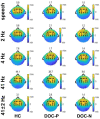Neural Tracking of Sound Rhythms Correlates With Diagnosis, Severity, and Prognosis of Disorders of Consciousness
- PMID: 33994924
- PMCID: PMC8113690
- DOI: 10.3389/fnins.2021.646543
Neural Tracking of Sound Rhythms Correlates With Diagnosis, Severity, and Prognosis of Disorders of Consciousness
Abstract
Effective diagnosis and prognosis of patients with disorders of consciousness (DOC) provides a basis for family counseling, decision-making, and the design of rehabilitation programs. However, effective and objective bedside evaluation is a challenging problem. In this study, we explored electroencephalography (EEG) response tracking sound rhythms as potential neural markers for DOC evaluation. We analyzed the responses to natural speech and tones modulated at 2 and 41 Hz. At the population level, patients with positive outcomes (DOC-P) showed higher cortical synchronization to modulated tones at 41 Hz compared with patients with negative outcomes (DOC-N). At the individual level, phase coherence to modulated tones at 41 Hz was significantly correlated with Coma Recovery Scale-Revised (CRS-R) and Glasgow Outcome Scale-Extended (GOS-E) scores. Furthermore, SVM classifiers, trained using phase coherences in higher frequency bands or combination of the low frequency aSSR and speech tracking responses, performed very well in diagnosis and prognosis of DOC. These findings show that EEG response to auditory rhythms is a potential tool for diagnosis, severity, and prognosis of DOC.
Keywords: EEG; auditory steady state response; disorders of consciousness; machine learning; neural synchronization.
Copyright © 2021 Xu, Zou, He, Wen, Li, Gao, Ding and Luo.
Conflict of interest statement
The authors declare that the research was conducted in the absence of any commercial or financial relationships that could be construed as a potential conflict of interest.
Figures








Similar articles
-
Phase Property of Envelope-Tracking EEG Response Is Preserved in Patients with Disorders of Consciousness.eNeuro. 2023 Aug 10;10(8):ENEURO.0130-23.2023. doi: 10.1523/ENEURO.0130-23.2023. Print 2023 Aug. eNeuro. 2023. PMID: 37500493 Free PMC article.
-
Auditory steady-state response to chirp-modulated tones: A pilot study in patients with disorders of consciousness.Neuroimage Clin. 2020;27:102261. doi: 10.1016/j.nicl.2020.102261. Epub 2020 Apr 22. Neuroimage Clin. 2020. PMID: 32388346 Free PMC article.
-
40Hz auditory steady-state responses in patients with disorders of consciousness: Correlation between phase-locking index and Coma Recovery Scale-Revised score.Clin Neurophysiol. 2017 May;128(5):799-806. doi: 10.1016/j.clinph.2017.02.012. Epub 2017 Feb 28. Clin Neurophysiol. 2017. PMID: 28319881
-
Low- and medium-rate auditory steady-state responses in patients with prolonged disorders of consciousness correlate with Coma Recovery Scale - Revised score.Int J Psychophysiol. 2019 Oct;144:56-62. doi: 10.1016/j.ijpsycho.2019.08.001. Epub 2019 Aug 2. Int J Psychophysiol. 2019. PMID: 31381936
-
Electrophysiological and Neuroimaging Studies - During Resting State and Sensory Stimulation in Disorders of Consciousness: A Review.Front Neurosci. 2020 Sep 15;14:555093. doi: 10.3389/fnins.2020.555093. eCollection 2020. Front Neurosci. 2020. PMID: 33041757 Free PMC article. Review.
Cited by
-
Effect of topographic comparison of electroencephalographic microstates on the diagnosis and prognosis prediction of patients with prolonged disorders of consciousness.CNS Neurosci Ther. 2024 Mar;30(3):e14421. doi: 10.1111/cns.14421. Epub 2023 Sep 7. CNS Neurosci Ther. 2024. PMID: 37679900 Free PMC article.
-
Individualized music induces theta-gamma phase-amplitude coupling in patients with disorders of consciousness.Front Neurosci. 2024 Jul 1;18:1395627. doi: 10.3389/fnins.2024.1395627. eCollection 2024. Front Neurosci. 2024. PMID: 39010944 Free PMC article.
-
Phase Property of Envelope-Tracking EEG Response Is Preserved in Patients with Disorders of Consciousness.eNeuro. 2023 Aug 10;10(8):ENEURO.0130-23.2023. doi: 10.1523/ENEURO.0130-23.2023. Print 2023 Aug. eNeuro. 2023. PMID: 37500493 Free PMC article.
-
Speech prediction of a listener via EEG-based classification through subject-independent phase dissimilarity model.Sci Rep. 2025 Jul 18;15(1):26174. doi: 10.1038/s41598-025-12135-y. Sci Rep. 2025. PMID: 40681689 Free PMC article.
References
LinkOut - more resources
Full Text Sources
Other Literature Sources

